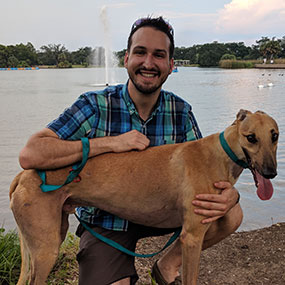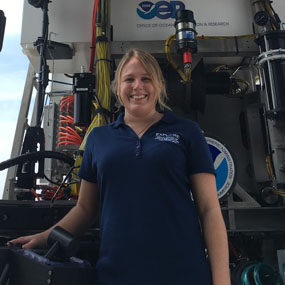
This media resources page provides members of the media with information and resources, including broadcast-, print-, and web-quality imagery, developed during the Deep Connections 2019: Exploring Atlantic Canyons and Seamounts of the United States and Canada expedition.
From August 6–September 15, 2019, NOAA and partners will conduct a telepresence-enabled ocean exploration expedition on NOAA Ship Okeanos Explorer to collect critical baseline information about unknown and poorly understood deepwater areas of the U.S. and Canadian Atlantic continental margin. The deep waters off the U.S. and Canadian east coast contain a wide diversity of poorly explored deepwater habitats and geological features that are of interest to resource managers and scientists. The North Atlantic is of vital importance to humankind, providing a variety of goods and services (e.g., seafood, recreation, tourism, and transportation) that provide employment and livelihood opportunities for millions of people.
Leg 1 of the expedition, from August 6–20, will focus on the collection of seafloor and water column data using the Okeanos Explorer’s advanced mapping systems. Leg 2, from August 26–September 15, will include both mapping and remotely operated vehicle (ROV) operations, with video from ROV dives streamed online daily in real time from August 27–September 14. Dive sites are expected to include submarine canyons and slope habitats, seamounts, deep-sea coral and sponge communities, midwater habitats, unique geological features, and other deep-sea habitats.
On this page:
Importance | Objectives | Partners | Who? | Videos & Images | Background Info | Contact Info
The U.S. East Coast is one of the country’s most populous coastal areas. Thus, it is critical that we understand the resources and hazards off its shores so we can best manage those resources and protect Americans. Despite its critical importance, we know very little about the deep waters and seafloor off this coast and have only begun to understand the region’s deep-sea resources, oceanography, bathymetry, geology, ecosystems, and trans-Atlantic biological connectivity.
The Deep Connections 2019 expedition to explore deepwater areas along the Atlantic margin off the U.S. and Canadian east coast will fill gaps in our understanding of the region, providing critical deepwater data needed to maintain the health of our ocean, sustainably manage our marine resources, accelerate economies, and build a better appreciation of the value and importance of the ocean in our everyday lives. Also, this is one of several expeditions on NOAA Ship Okeanos Explorer between 2018–2020 that contribute to NOAA’s Atlantic Seafloor Partnership for Integrated Research and Exploration (ASPIRE), a major multiyear, multinational collaborative ocean exploration field program focused on raising collective knowledge and understanding of the North Atlantic Ocean.
Submarine canyons and seamounts: During the expedition, scientists both on the ship and on shore will explore the sensitive communities that live within submarine canyons and seamounts along the Atlantic continental margin. These features can serve as hotspots of biodiversity, harboring a great abundance and variety of marine organisms, including commercially, recreationally, and ecologically important species, often warranting increased management and protection. Exploration of these submarine canyons and seamounts may also offer insights into the geologic history of the region and help us better assess the potential for natural hazard events such as submarine landslides.
Deep-sea coral and sponge communities: The team will work to characterize the diversity and extent of coral and sponge communities, which represent some of the most valuable marine ecosystems on the planet, creating structures that provide shelter, food, and nursery habitat to other invertebrates and fish. A better understanding of how populations of coral, sponge, fish, and other deep-sea species are related across geographically separated locales (a concept known as connectivity) can offer insight into the resilience of those populations and thus is important for predicting the impacts of human activities on coral communities and for developing solid plans for their protection.
Predictive modeling: Data collected during this expedition will be used to ground truth and inform deep-sea coral and sponge habitat suitability models and geohazard models. Habitat models allow scientists to make inferences about where certain species and habitats can be found (or not) without actually having to visit an area, filling gaps in our understanding of the vast ocean. Helping us to understand the likelihood that animals will be present in a certain area can also inform decisions about where to explore next. Models can also be used to predict where hazards such as submarine landslides are likely to occur in the future. Ground truthing the results of models by visiting a site, to see if what the model said would be there actually is, will help improve the models and ultimately improve our understanding of the deep ocean by allowing us to estimate conditions in the absence of physical data.
Connectivity and transboundary exploration: Since animals in the ocean do not recognize geopolitical borders, the team will work across U.S.-Canadian boundaries to gain a better understanding of the North Atlantic as a whole and how populations of coral, sponge, fish, and other deep-sea species are related across geographically separated locales. Understanding connectivity can offer insight into the resilience of those populations. Through this transboundary exploration, we a forging and strengthening international partnerships between the United States and Canada—making “deep connections.”
The Deep Connections 2019 expedition will address science and management priorities put forward by scientists and managers from the United States and Canada as well as international working groups supporting the Atlantic Ocean Research Alliance and the European Union’s Horizon 2020 program. During the expedition, we will work to meet a combination of science, education, outreach, and open data objectives that will support management decisions at multiple levels. These objectives include:
The expedition involves a number of NOAA partners including the Office of Marine and Aviation Operations; the National Marine Fisheries Service’s Northeast Fisheries Science Center, Deep Sea Coral and Research and Technology Program, and Greater Atlantic Regional Fisheries Office; the National Ocean Service’s Office of National Marine Sanctuaries and National Centers for Coastal Ocean Science; the National Environmental Satellite, Data, and Information Service’s National Centers for Environmental Information; and the Office of Oceanic and Atmospheric Research's Office of Ocean Exploration and Research. Other partners include the U.S. Fish and Wildlife Service, U.S. Geological Survey, Fisheries and Oceans Canada , and PEW Charitable Trusts .
The individuals listed below will primarily lead activities during the expedition. They will coordinate input from multiple scientists and managers participating from shore to plan dives and are several of the voices you hear on the live video feeds and the primary participants in outreach events. For a full list of our on-ship team, please visit this page.

Geology Science Lead, National Research Council Postdoctoral Fellow, Naval Research Lab, Stennis Space Center, Mississippi
Leg 2
Dr. Jeff Obelcz is a geological oceanographer at the Naval Research Lab in Stennis, Mississippi. Despite being born and raised in landlocked Pennsylvania, childhood trips to the Outer Banks in North Carolina instilled a persistent curiosity about the ocean and its workings. Jeff began his formal study of the marine environment at Coastal Carolina University in Conway, South Carolina, and after graduating with a B.S. in Marine Science, he worked as a marine geologist at the U.S. Geological Survey Coastal and Marine Science Center in Woods Hole, Massachusetts. After obtaining his Ph.D. from Louisiana State University, Jeff moved to New Orleans, adopted his greyhound Fletcher, and began a postdoc at the Naval Research Lab. Jeff’s research focuses on submarine landslides, mudflows, and the environments in which such geohazards are prevalent, primarily river deltas and continental margins. These phenomena are studied through seafloor mapping, sampling, and more recently, predictive modeling via machine learning. Jeff will serve as co-science lead on this expedition, coordinating with the onshore science team and narratively interpreting the geology observed during remotely operated vehicle (ROV) dives.

University of Hawai‘i
Leg 2
Meagan Putts is a deep-sea researcher at the University of Hawai‘i whose focus is on deep-sea coral and sponge communities. Meagan is part of an experienced team of scientists specializing in imagery analysis that most notably assembled the benthic animal guide and completed the video analysis from the 2015-2017 CAPSTONE expeditions. She also designed and maintains the Hawaii Undersea Research Laboratory (HURL) archive and is part of the team that operates the ROV Lu‘ukai. She completed her Masters in Marine Science at Hawai‘i Pacific University in Honolulu, Hawaii, and her Bachelors of Science in Marine Science and Visual Arts at Eckerd College in St. Petersburg, Florida. This will be Meagan’s fourth expedition aboard the Okeanos Explorer. She previously sailed as a science lead during the 2017 expedition Deep-sea Symphony: Exploring the Musicians Seamounts and as an Explorer-in-Training. When not in the office or at sea, Meagan enjoys surfing and creating art which often incorporates themes of deep-sea marine life.

Expedition Coordinator, NOAA Office of Ocean Exploration and Research
Leg 2
Dr. Daniel Wagner works as an expedition coordinator for the NOAA Office of Ocean Exploration and Research. Daniel has conducted fieldwork on deep-sea ecosystems since 2006 and has since spent over 500 days at sea during 25 multi-disciplinary research expeditions that explored deep-sea habitats throughout the Indo-Pacific, Atlantic, and Southern Oceans. Daniel grew up in Ecuador, where at a young age he interned at the Galapagos National Park, an experience during which he developed a deep fascination for nature and the oceans. Daniel then moved to Hawaii, where he earned a Bachelor of Science in Biology from Hawaii Pacific University, as well as a Master of Science and Ph.D. degrees in Oceanography from the University of Hawaii at Mānoa. Daniel resides in Charleston, South Carolina.

Mapping Lead, NOAA Office of Ocean Exploration and Research
Leg 2
A native of Long Island, New York, Mike took a deep interest in ocean science at a young, age growing up in and on the water. After graduating from SUNY Geneseo with a degree in geological sciences, Mike continued his education at the School of Marine and Atmospheric Sciences at Stony Brook University. At Stony Brook, he worked on several projects, including acoustic mapping of coastal areas, coastal sediment management, remote sea level monitoring, submarine groundwater discharge, and applying his GIS proficiencies. Mike’s M.S. thesis focused on the processing of multibeam backscatter and its relationship to the physical characteristics of the seafloor. After completing a graduate certificate in geospatial science and earning a reputation as a reliable field scientist, Mike started a new position as a hydrographic analyst with NOAA’s Sandy Integrated Ocean and Coastal Mapping team at the Center for Coastal and Ocean Mapping (CCOM) at UNH. At CCOM Mike processed outside to NOAA hydrographic datasets, examined additional applications for topobathymetric lidar, collaborated on a seafloor imaging device, and served as a physical scientist supporting hydrographic surveys. As the newest member of the Okeanos Mapping Team, Mike is truly excited to support their mission exploring the oceans. During his off hours, Mike can be found cooking, hiking, or watching movies.
Dive highlight videos, short video clips, and photos will be posted online as they are available.
Please contact Emily Crum for high-res footage, B-roll, and other materials at Emily.Crum@noaa.gov.
Access LIVE video feeds here
Expedition home page
NOAA Office of Ocean Exploration and Research
Emily Crum
Office: (843) 460-9772 | Mobile: (202) 424-0081
Email Address: emily.crum@noaa.gov
NOAA Office of Marine and Aviation Operations
David Hall
Public Affairs Officer
Office: (301) 713-7671
Email Address: david.l.hall@noaa.gov
NOAA Office of National Marine Sanctuaries
Vernon Smith
National Media Coordinator
Office: (301) 713-3125 x248
Email Address: vernon.smith@noaa.gov
NOAA National Marine Fisheries Service
John Ewald
Director of Public Affairs
Office: (301) 427-8029
Email Address: john.ewald@noaa.gov
NOAA Greater Atlantic Regional Fisheries Office
Jennifer S. Goebel
Public Affairs Officer
Office: (978) 281-9175
Email: jennifer.goebel@noaa.gov
NOAA Northeast Canyons and Seamounts Marine National Monument
Jennifer Anderson
NEPA Coordinator
Office: (978) 281-9226
Email: jennifer.goebel@noaa.gov
U.S. Fish and Wildlife Service
Terri Edwards
Public Affairs Chief
Office: (413) 253-8324
Email: terri_edwards@fws.gov
Fisheries and Oceans Canada
Stephen Bornais
Communications Advisor, Media Relations
Maritimes Region
Fisheries and Oceans Canada
Office: (902) 471-6797
Email: Stephen.Bornais@dfo-mpo.gc.ca